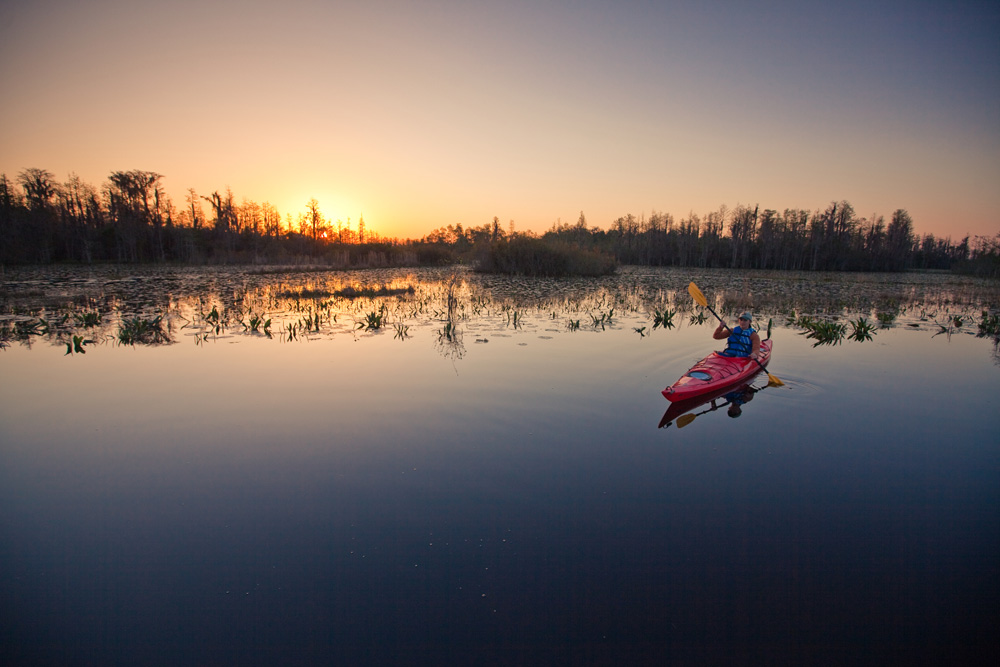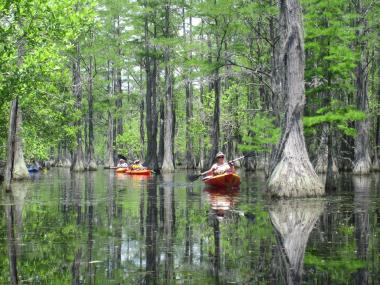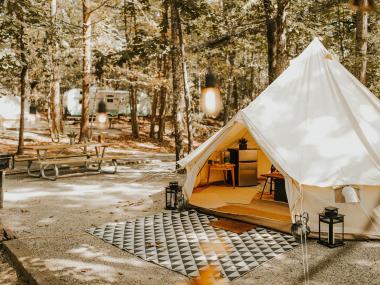Okefenokee Nature Trip
A bucket list trip for every outdoor adventurer, this Deep South safari through a mystic dark swamp is like no other trip on Earth.
Expect those little hairs on the back of your neck to stand on end as you try to escape the feeling that you’re being watched. Alligator eyes confirm that you are, indeed, being watched as they glisten above the water’s black eerie surface and peer out from behind majestic cypress trees along the shore.
Some critters are bolder: a great blue heron may swoop in and land a few feet away from you, while a dragonfly might alight on your shoulder just as you spy a snake soaking up some sun on a fallen log. Any exploration of the Okefenokee National Wildlife Refuge will be a heart-thumping safari you will never forget.
While your nature trip to Okefenokee is guaranteed to be exhilarating, the one thing it won't be is dangerous (as long as you follow guidelines and common sense). "If it were dangerous, we wouldn't let anyone out there," says Joy Campbell, who, with her husband Chip, operates Okefenokee Adventures, the official cooperating partner of the Okefenokee National Wildlife Refuge.
"It’s an awesome ecosystem," she says of the largest "blackwater" swamp in North America. "There's nothing to be afraid of."
As many as 20,000 alligators consider this spongy peat bog home, so the odds of spotting the reptiles during a visit are high, though there's no guarantee. Egrets, herons, ibis and cranes, standing ankle-deep in mirrored-black water are also common sights. Circling hawks, hooting owls, rambling turkeys, leaping white-tailed deer and playful otters are additional possibilities to see during your trip. Fox squirrels and gopher tortoises are not shy, while black bears and bobcats are Okefenokee's more elusive residents. Listen for the chiseling and pecking of the endangered red-cockaded woodpecker.
From white water lilies to red holly berries, more than 600 plant species reside in Okefenokee and reflect the season. Buds and blossoms burst each spring for the biggest annual display. Bugs are thickest in hot summer months, though the early hours of the day are generally comfortable. Fall brings subtle color changes, like the cypress needles' transformation to burnt orange and the appearance of the delicate yellow tickseed sunflower. Migratory birds visit in winter months, which happen to be the best season for serious bird-watching.
While navigating a tour boat through this primitive wetland on a 90-minute or four-hour tour, expect expert guides to share facts and legends about the swamp along with personal stories that will both raise eyebrows and elicit laughs. Along with expertise on alligator biology, wetland ecology and cultural history, all guides possess pure passion for Okefenokee, which shines through each anecdote. If you prefer to go it alone, rent a kayak or canoe.
You can also hike, bike or drive along miles of trails — just stop in the interpretative center or gift shop to pick up maps and details before heading out to peek at the authentic swamp homestead. If complete immersion is the goal for your trip, try overnight camping in the backcountry wilderness. Fishing and hunting are also available to license holders.
Dense growth of pond cypress, saw-tooth palmetto, live oak, long-leaf pine and other plants dominate the landscape in areas, while other spaces are open because of fires that burned through the Okefenokee in 2007 and 2011. Fire is a natural and recurring part of the swamp’s history.
"The swamp looks changed, but beautiful," Campbell says. "It grows back very quickly."
The Native American term Okefenokee means "land of trembling earth." Although you may not experience the ground trembling beneath your feet, you definitely will feel shivers of excitement as you discover Okefenokee.







